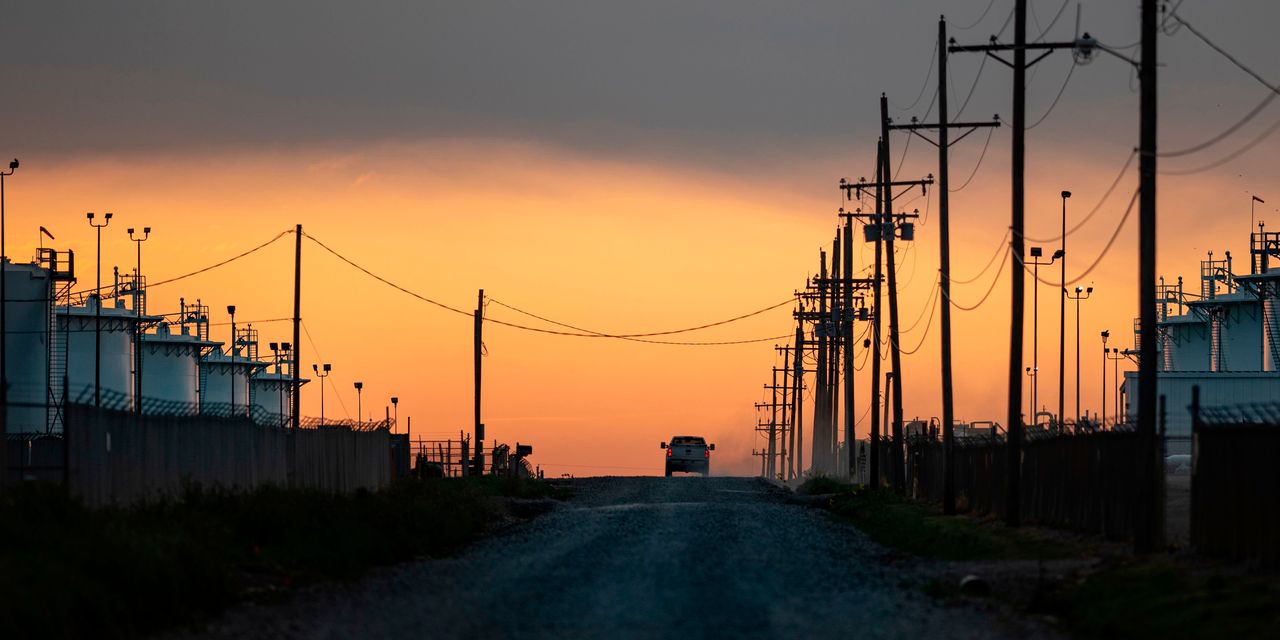Oil futures finished lower Wednesday for the first time in five trading sessions, with prices falling back from the three-month high they settled at a day earlier.
Losses for oil came on the heels of smaller-than-expected weekly declines in U.S. crude, gasoline and distillate inventories reported by the Energy Information Administration.
Price action
-
West Texas Intermediate crude for September delivery
CL.1,
-0.36%
fell 85 cents, or 1.1%, to settle at $78.78 a barrel on the New York Mercantile Exchange. -
September Brent crude
BRNU23,
-0.44% ,
the global benchmark, lost 72 cents, or 0.9%, at $82.92 a barrel on ICE Futures Europe. October Brent
BRN00,
-0.42% BRNV23,
-0.42% ,
the most actively traded contract, declined 69 cents, or 0.8%, to $82.56 a barrel. -
Back on Nymex, August gasoline
RBQ23,
-0.44%
rose 1.9% to $2.91 a gallon, while August heating oil
HOQ23,
-0.62%
added nearly 2.4% at $2.84 a gallon. -
August natural gas
NGQ23,
-6.00%
fell 2.4% to $2.67 per million British thermal units ahead of the contract’s expiration at the end of Thursday’s session.
Fed impact
Both WTI and Brent retreated Wednesday from Tuesday’s settlement at their highest prices since April 18. Prices had been supported by expectations for a supply deficit in the second half of the year.
Given ongoing cuts by Saudi Arabia, and the Atlantic hurricane season, strength in the energy complex is likely to continue in the days and weeks ahead, said Tariq Zahir, managing member at Tyche Capital Advisors.
Upside for oil, however, has been limited by fears of aggressive monetary tightening by global central banks that could spark a significant economic slowdown.
On Wednesday afternoon, the U.S. central bank raised its benchmark interest rate by a quarter-percentage point to a 22-year high. It also said it was prepared to do more to bring “elevated” inflation down.
While the Fed is “continuing to say they are prepared to raise rates further and keep policy restrictive for a prolonged period of time, the markets simply don’t believe that,” Tyler Richey, co-editor at Sevens Report Research, told MarketWatch.
“That lack of faith is underscored by Fed funds futures pricing in a more than 50% chance of a rate-cut by the end of Q1 [2024] since the Fed announcement,” he said.
Fed Chairman Powell said that depending on economic data, it was “certainly possible” the Fed would delivery another rate hike in September, or hold steady.
“As long as the market is right and the Fed will both achieve a soft economic landing and begin easing policy rates in the quarters ahead,” which is something we don’t anticipate, said Richey, then oil can “extend this mid-summer rally.”
However, “if we see Fed policy expectations take a hawkish shift and hard-landing/recession fears return, then we expect pain in energy markets as risks to consumer demand would be quickly repriced into the market,” he said.
Supply data
The Energy Information Administration on Wednesday reported that U.S. commercial crude inventories fell by 600,000 barrels for the week ended July 21.
On average, analysts polled by S&P Global Commodity Insights expected the report to show a decrease of 4.4 million barrels. The American Petroleum Institute late Tuesday reported a weekly increase of 1.3 million barrels, according to a source citing the data.
The EIA report also revealed supply falls of 800,000 barrels for gasoline and 200,000 barrels for distillates for the week. Analysts had forecast weekly inventory declines of 2 million barrels for gasoline and 2.3 million for distillates.
Read: Here’s what might lead to a 10% spike in retail gasoline prices
U.S. refinery use fell 0.9% to 93.4%, which helps “explain the notably smaller than expected drawdown in oil stockpiles,” said Sevens Report Research’s Richey. “However, if consumer demand was still strong we should have seen some larger drawdowns in the refined products, which further supports the thesis that demand for fuel at the pump is faltering.”
Last week, the gasoline supplied figure, which is an implied measure of consumer demand for fuel at the pump, stabilized with a modest rise of 85,000 barrels a day to 8.94 million barrels a day, said Richey. That followed sharp declines in the previous two reports, in the middle of the summer driving season.
Read the full article here













